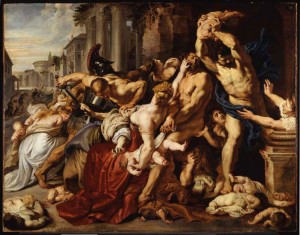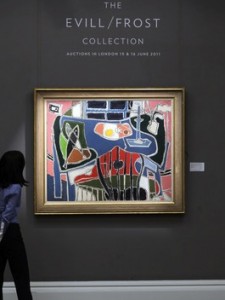Henry Wyndham is no ordinary man. His long and illustrious career has taken him all over the art world, from Christie’s to private dealing to hammering down world-record prices for artworks as a world-renowned auctioneer. Loved by all at Sotheby’s, during my internship I noted that his name was spoken with what can only be called reverence. In fact, there were cookies with his face on them at the Christmas Party… He also has an uncanny resemblance to Jeremy Clarkson. In appearance and height. But I digress. So I sat down with the connoisseur himself to ask a few questions…
1. What made you want to go into the art world?
From a very young age, I had the collecting bug. I collected stamps, and moved on to all sorts of things, like militaria, and when I was about 12 or 13, I started buying drawings. Really cheap ones – I had absolutely no money. I reckon I knew at 16 that I wanted to go into the art world, but I didn’t really know what ‘the art world’ meant.
2. What side of the art world were you most drawn to – commercial or academic?
There wasn’t any contest for me, because I really didn’t do well academically – I got rather poor A Levels and I never went to university. Also I was much more interested in the commercial side, so I was lucky. In the art world, there’s a fork in the road and you either go left into the commercial world or right into the academic… but in my case there was really no choice!
3. So where did you start?
I did the Sotheby’s Fine Art course in 1973 at what is now called the Sotheby’s Institute, and was taught by this incredibly charismatic figure who used a very non-academic, visual approach, and focused on your eye. He was just absolutely brilliant – very inspirational. Then I got offered a job at Christie’s, and I was there from October 21st 1974.
4. So for young people who want to train their eye, you recommend ‘looking’?
I personally think that there’s no substitute for looking – you can read all the books in the world… but art, in my view, is there to be looked at. I’m relatively self-taught – I suppose you could say I was a type of apprentice in that I joined Christie’s and learnt as I went along. Also I worked hard at it – I used to go to the National Gallery in my lunch hour. That’s immensely helpful – visiting museums and just looking and looking and developing your eye.
5. Why did you move on to private sales?
I was married and I had children, and I needed to try and make some money. I’m glad I did it – I probably wasn’t terribly good at it, but I think it was very good for what I do now, as I understand where the dealers are coming from.
6. The auction and private worlds used to be very separate – how much do you think that they are now merging?
I’ve been in the art world for the best part of forty years, and I’d say there’s been more change in the last five years than the previous thirty-five – the role of the auction house has changed dramatically, and one of the changes is the private sales that they do. I know it’s not necessarily in the interest of the dealers, but it’s a natural progression – we know who the buyers are and we know who owns the pictures. But the main core of our business is and hopefully will always remain as auctioneers.
7. Best thing about working at an auction house?
It’s the nature of the business – the idea that you get beautiful things for sale that you handle, and there’s this theatrical moment when you actually sell it. What I like about an auction is that it has a conclusion of somebody actually putting a hammer down.
8. If you could relive any moment of your career, what would it be?
Oh god… actually funnily enough I think the greatest moment of my career was selling the wonderful Rubens – The Massacre of the Innocents – because I think that was the greatest painting that has been on the art market in my forty years. I can’t think of anything to match it. I know it’s not the most expensive, but for me it’s far-and-away the greatest.

'Massacre of the Innocents' by Peter Paul Rubens, c.1611-12, Art Gallery of Ontario. (Sold at Sotheby's London, July 2002 for £49.5 million)
9. Something surprising/unexpected/unusual that you have come across?
The most exciting collection that I’ve seen was probably the Evill/Frost collection that we sold last year. Going into that house for the first time and seeing it was a complete eye-opener – it wasn’t just the [Stanley] Spencers, it was things like very early Freud drawings, and a fantastic Patrick Heron from 1954. I was completely knocked out – normally when you go places you vaguely know what they’ve got, and with this I just hadn’t a clue.

Patrick Heron's 'The Blue Table with Window: 1954' realised £1,049,250 at the Evill/Frost Collection sale (est. £250,000-£350,000)
10. Where does your expertise lie?
I’m very lucky in that I’m a sort of jack of all trades – I started in Old Masters and then I moved into 19th Century European, then English pictures, then Modern British, and now I suppose in a way I’m more 20th C, so I’ve really covered the whole spectrum.
11. If you could own any work of art in the world, what would it be? Money and location no object…
Oh my god… you might have given me six months to think about this… Actually, I know exactly what it is – the wonderful picture in the Prado by Rogier van der Weyden, The Descent from the Cross. That is, in my view, the greatest picture I know. That’s the one.

Henry's personal pick - 'The Deposition from the Cross' by Flemish artist Rogier van der Weyden, c.1435, Museo del Prado, Madrid
12. Many AHA students want to go into the commercial art world – what advice would you give to them?
You need to be very passionate about the subject, and you’ve got to be prepared to do a lot of hard work. Dealing with people is also very important – it’s very much a people business. And… just keep on knocking at the door!


